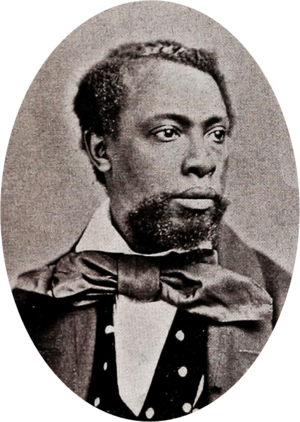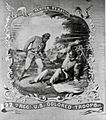David Bustill Bowser facts for kids
Quick facts for kids
David Bustill Bowser
|
|
|---|---|
 |
|
| Born | January 16, 1820 Philadelphia, Pennsylvania, US
|
| Died | June 30, 1900 Philadelphia, Pennsylvania, US
|
|
Notable work
|
Portraits of John Brown, Abraham Lincoln; battle flags for American Civil War military units |
| Spouse(s) | Elizabeth Harriet Stevens Gray Bowser (1831–1908) |
David Bustill Bowser (born January 16, 1820, died June 30, 1900) was an important African-American artist from the 1800s. He was known for his portraits and for designing battle flags during the American Civil War.
Bowser created flags for eleven African-American regiments. He also painted famous people like U.S. President Abraham Lincoln and John Brown, who fought against slavery. Historians say his art showed some of the first positive images of African Americans created by an African-American artist. Besides his art, Bowser was very active in politics. He helped pass important laws in Pennsylvania that gave more rights to African Americans after the war.
Early Life and Family
David Bustill Bowser was born in Philadelphia, Pennsylvania, on January 16, 1820. His grandfather, Cyrus Bustill, was a formerly enslaved man who bought his freedom. Cyrus helped start the Free African Society in Philadelphia. David's father, Jeremiah Bowser, was also freed from slavery by a group of Quakers.
David was part of the well-known Bustill family. He learned art from his cousin, Robert Douglass Jr., who studied at the Pennsylvania Academy of the Fine Arts. David also went to a private school run by Douglass's sister, Sarah Mapps Douglass.
David Bustill Bowser married Elizabeth Harriet Stevens Gray, who was a seamstress. They had two children: Raphael Bowser, who also became an artist, and Ida Elizabeth (Bowser) Asbury, a violinist and music teacher. The Bowsers were known for helping their community. They earned a living by designing and painting banners, signs, and uniforms for different groups in Philadelphia.
Art and the Civil War
In the 1840s, Bowser painted banners for many different clients. He also painted a portrait of Jacob C. White Jr., a leading abolitionist. Bowser and his family strongly supported the movement to end slavery. Their home even became a safe stop on the Underground Railroad, a secret network that helped enslaved people escape to freedom.
In 1858, Bowser painted a portrait of John Brown when Brown visited the Bowser home. Around this time, Bowser also finished his painting called The Firebell in the Night.
During the American Civil War, Bowser helped recruit African-American soldiers. In 1863, after President Abraham Lincoln announced the Emancipation Proclamation, Bowser was asked to design flags for eleven African-American regiments. These regiments were preparing to join the war at Camp William Penn near Philadelphia.
The first flag Bowser designed was paid for by the Contraband Relief Association (CRA). This group was led by Elizabeth Keckley, who had been enslaved and later became Mary Todd Lincoln's dressmaker. The CRA presented this flag to the 1st United States Colored Infantry.
Other flags designed by Bowser carried powerful messages:
- The flags for the 127th and 3rd regiments said, "We will prove ourselves men" and "Rather Die Freemen, Than Live To Be Slaves." These flags showed black soldiers protecting white women who represented Columbia, a symbol of the United States.
- The 45th regiment's flag said, "One Cause, One Country." It showed a black soldier holding an American flag in front of a statue of George Washington, with black troops fighting in the background.
- The 24th regiment's flag showed a black soldier praying on a hill, with the words, "Let Soldiers in War, Be Citizens in Peace."
For the 22nd USCT flag, Bowser painted a black soldier pointing a bayonet at a Confederate soldier who had dropped his flag. Below this, the flag read, "Sic semper tyrannis," which means "thus always to tyrants."
In 1865, Bowser also painted a portrait of President Lincoln. This image was later used for the five-dollar bill after the Civil War.
After the War
After the war, Bowser continued his art, but he didn't get many big art jobs. So, he and his wife focused more on making banners and special clothing for organizations.
Bowser also became more involved in politics. In 1867, he worked with the Pennsylvania Equal Rights League. He helped them get a law passed that stopped public transportation from keeping people out because of their race or color. This was a big success for civil rights in Pennsylvania.
In 1870, Bowser led a large celebration in Philadelphia. This event celebrated the Fifteenth Amendment, which gave African-American men the right to vote. Many important people attended, including Frederick Douglass and Lucretia Mott.
Bowser also met with President Ulysses S. Grant in 1872. He and others from the Equal Rights League asked President Grant to support laws that would protect the civil rights of all citizens. While Grant agreed that all citizens should be equal, he said such laws would likely come later.
Later Life and Legacy
David Bustill Bowser passed away in Philadelphia on June 30, 1900. He was buried at the Eden Cemetery.
Sadly, many of the original Civil War battle flags he designed were lost in the 1940s. They had been stored at West Point but were later thrown away. Luckily, images of seven of these important flags still exist today.
Gallery
-
Portrait of U.S. President Abraham Lincoln, 1865
-
Portrait of abolitionist John Brown, 1865










